Happy 124th Birthday to Ateneul Roman!
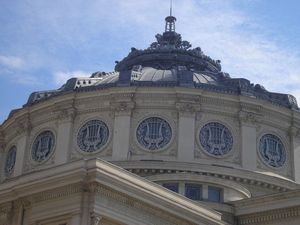 (Photo: Sarah In Romania) The steps of the Romanian Athenaeum concert hall in the centre of Bucharest are my most favourite of all places for watching the world go by, the sun go down or simply 'holding the moment'. Of course, attending a concert or three in its beautifully ornate, circular, domed main concert hall (or even the "Mouse Hole" downstairs) is just as much cause for a deep and contented sigh. When my students used to ask me which monument I thought best represented Bucharest (it was one of their favourite questions to ask a foreigner!), my answer was always the same - "Ateneul Roman". Not the hideous Casa Nebunului, that's for sure.
(Photo: Sarah In Romania) The steps of the Romanian Athenaeum concert hall in the centre of Bucharest are my most favourite of all places for watching the world go by, the sun go down or simply 'holding the moment'. Of course, attending a concert or three in its beautifully ornate, circular, domed main concert hall (or even the "Mouse Hole" downstairs) is just as much cause for a deep and contented sigh. When my students used to ask me which monument I thought best represented Bucharest (it was one of their favourite questions to ask a foreigner!), my answer was always the same - "Ateneul Roman". Not the hideous Casa Nebunului, that's for sure.
Today, Ateneul Roman is home to the George Enescu Philharmonic Orchestra and the George Enescu International Music Festival. Take a look at this marvellous virtual tour should you never have had the pleasure to visit.
In 1865, cultural and scientific personalities Constantin Esarcu, V. A. Urechia, and Nicolae Creţulescu founded the Romanian Atheneum Cultural Society. To serve its purposes, the Romanian Athenaeum, a building dedicated to art and science, was erected in Bucharest, says Wikipedia.
 (Photo: Sarah In Romania) The building was designed by French architect Albert Galleron on a property that had belonged to the Văcărescu family and inaugurated on 14th February, 1888, although work continued until 1897. It was built with money collected publicly following a national lottery - 500,000 tickets were issued, costing one leu each. The scientist Constantin Esarcu (1836-1898), addressed an appeal to the people of Romania: "Give one leu for the Ateneu'!" which became a lesson in unity and an awakening of national conscience. The slogan is still remembered affectionately today.
(Photo: Sarah In Romania) The building was designed by French architect Albert Galleron on a property that had belonged to the Văcărescu family and inaugurated on 14th February, 1888, although work continued until 1897. It was built with money collected publicly following a national lottery - 500,000 tickets were issued, costing one leu each. The scientist Constantin Esarcu (1836-1898), addressed an appeal to the people of Romania: "Give one leu for the Ateneu'!" which became a lesson in unity and an awakening of national conscience. The slogan is still remembered affectionately today.
In addition to being a symbol of culture, Ateneul Roman is also a historical site, for, on December 29, 1919, a conference of leading Romanians voted there to ratify the unification of Bessarabia, Transylvania, and Bukovina with the Romanian Old Kingdom to constitute Greater Romania.
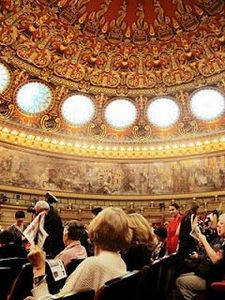 (Photo: Silvia Colfescu) The graceful, circular-form of the building is owed to an already existing foundation in the Diocese Garden, which had been destined for ... a circus!! Its facade was inspired by the architecture of ancient Greek temples with its majestic row of columns which support a triangular pediment. It seems like an oasis, so close to the busyness of Calea Victoriei and the carpark nearby. Sitting on those steps looking out onto the statue of Mihai Eminescu and the lovely garden, I could have stayed for hours, and in spring and summer very often did, comfortable with a flask of coffee and a good book.
(Photo: Silvia Colfescu) The graceful, circular-form of the building is owed to an already existing foundation in the Diocese Garden, which had been destined for ... a circus!! Its facade was inspired by the architecture of ancient Greek temples with its majestic row of columns which support a triangular pediment. It seems like an oasis, so close to the busyness of Calea Victoriei and the carpark nearby. Sitting on those steps looking out onto the statue of Mihai Eminescu and the lovely garden, I could have stayed for hours, and in spring and summer very often did, comfortable with a flask of coffee and a good book.
When I lived in Bucharest, I went for a job at Ateneul Roman. Having sung in choirs from the age of seven either in the UK or in France, I was determined not to stop during my time in Bucharest. I went for an audition with Mr. Pruner (chef du choeur and conductor) having seen a poster one day advertising the Verdi Requiem. Knowing the work inside out, I decided on a whim to see if I could join, for the very thought of singing in that beautiful concert hall made my heart skip a beat. Mr Pruner was charming (as was the lady who turned up to accompany me) and after two arias and a sight-reading test, I was accepted. Hurrah!! Since there was a rehearsal at that very moment, I joined the Alto I section at once and got to work. It was a long rehearsal from what I can remember, and when it was over, the lady who had played the piano for my audition asked if I'd like a tour of Ateneul. Wow! Off we went together... It was the most magical of moments! I was shown the back-stage area which was full of what had been scenery and all kinds of bits and pieces, the room where the choir members could change, eat, etc. Into the main hall we went - just the two of us - and I stood there like a goldfish, opening and closing my mouth in wonder, as she explained the fresco that encircles the walls depicting the history of the Romanian people in 25 'chapters'. Of course, I had sat in the audience many times and gazed at it, but hadn't known who was who nor what chapters referred to which parts in history.
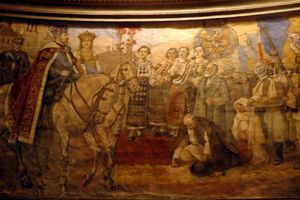 (Photo: Sarah In Romania) There they were, the stories I had been told since my love affair with Romania had begun - Emperor Traian entering Dacia; Stefan cel Mare (who was actually not so 'mare' but rather short!); Mihai Viteazu and the unification of the three principalities; Horea, Closca and Crisan the three heroes of the Peasants' Revolt; Carol I; my favourite - King Ferdinand and Queen Marie of Romania and many more I didn't know... my 'guide' was most amused by my evident excitement and took it as a sign to keep going. I was all ears.
(Photo: Sarah In Romania) There they were, the stories I had been told since my love affair with Romania had begun - Emperor Traian entering Dacia; Stefan cel Mare (who was actually not so 'mare' but rather short!); Mihai Viteazu and the unification of the three principalities; Horea, Closca and Crisan the three heroes of the Peasants' Revolt; Carol I; my favourite - King Ferdinand and Queen Marie of Romania and many more I didn't know... my 'guide' was most amused by my evident excitement and took it as a sign to keep going. I was all ears.
Here too, she said, on 1st March 1898, the chords of George Enescu's divine symphonic suite "Poema Romana" rang out for the first time. Holding the baton was George Enescu himself, aged only seventeen. Other great names that had performed on that very stage flashed before me: Celibidache, Lipatti, Arthur Rubinstein, Pablo Casals, Stravinsky, Richard Strauss, Bartok, Ravel....
Moving closer to the present, she explained that by some miracle, Ateneul Roman had survived the bombardments of World War II while many buildings surrounding it had succumbed. She also told me that the beautiful fresco had been covered up during the communist era so people would not be able to see their history of Emperors and Kings - King Carol II and King Mihai were erased completely... Extensive reconstruction and restoration work was carried out by a Romanian construction company and the restoration painter, Silviu Petrescu, in 1992.
 (Photo by Tom) From this marvellous tour with history lesson thrown in, I was then whisked off to the offices for 'administrative purposes'. Introduced as 'a new choir member', I was asked for my cartea de munca. Of course, not being Romanian, I didn't have one. I suggested my music CV instead. No. That was no good. The secretary frowned at me. It had to be a carte de munca. I shrugged. Sorry. No carte de munca. She shrugged, too. No job, then, for without it, I can't be employed. I explained that I already had a job and that I didn't want to be employed. I just wanted to sing. "Nu se poate," she said and started to shuffle papers that didn't need shuffling. "But...I just want to sing. You don't have to pay me! I'll come to the rehearsals and sing in your concerts because I have passed the audition. If you don't have to pay me, you don't need my cartea de munca. You don't even have to document anything," I explained. Nope. Nu se poate.... And that was that.
(Photo by Tom) From this marvellous tour with history lesson thrown in, I was then whisked off to the offices for 'administrative purposes'. Introduced as 'a new choir member', I was asked for my cartea de munca. Of course, not being Romanian, I didn't have one. I suggested my music CV instead. No. That was no good. The secretary frowned at me. It had to be a carte de munca. I shrugged. Sorry. No carte de munca. She shrugged, too. No job, then, for without it, I can't be employed. I explained that I already had a job and that I didn't want to be employed. I just wanted to sing. "Nu se poate," she said and started to shuffle papers that didn't need shuffling. "But...I just want to sing. You don't have to pay me! I'll come to the rehearsals and sing in your concerts because I have passed the audition. If you don't have to pay me, you don't need my cartea de munca. You don't even have to document anything," I explained. Nope. Nu se poate.... And that was that.
 (Photo by Tom) I left Ateneul Roman nearly five hours later, utterly crest-fallen, terribly disappointed, went to the Verdi concert the following month, and remember crying all the way through it! By the Lacrimosa, I was awash! There ended my hopes of standing on the stage and singing in my favourite monument of the entire world!!!!
(Photo by Tom) I left Ateneul Roman nearly five hours later, utterly crest-fallen, terribly disappointed, went to the Verdi concert the following month, and remember crying all the way through it! By the Lacrimosa, I was awash! There ended my hopes of standing on the stage and singing in my favourite monument of the entire world!!!!
A friend from the US and writer of the blog, Tom's Place, visited Bucharest that summer and, once again, we went to Ateneul Roman. Aghast that he had never been inside, I popped into the little office round the corner and begged the caretaker to let us in since the main door was closed. This, he kindly did, and accompanied us to the main hall, the "Mouse Hole" (the little hall downstairs) and once again, I swooned at the majestic marble staircases, the elegance, the graceful lines and architectural beauty of the Ateneul Roman. We stayed for a couple of hours and photographed everything we could like a pair of things possessed until our (or rather, my) batteries went flat!
 (Photo by Tom) My memories of this incredibly romantic place are always filled with great affection. My imagination is overwhelmed with enchanting, magical snap-shots in rapid succession of a Bucuresti de alta data back in a time when one dressed up for concerts (actually, there, they still do), when top-hatted gentlemen helped ladies in elegant gowns clutching tiny, beaded bags and opera glasses out of carriages or motor-cars and when there was a real and admirable inteligentia alive and well in Romania's capital. Ateneul Roman is a major part of 'my' Bucharest and my heart longs to be sitting on those steps once again waiting for friends or lost in my book. It longs for the lovely circular concert hall, the stunning fresco and the first lulling notes of Fauré's Requiem or Schumann's "Carnaval" to envelope it.
(Photo by Tom) My memories of this incredibly romantic place are always filled with great affection. My imagination is overwhelmed with enchanting, magical snap-shots in rapid succession of a Bucuresti de alta data back in a time when one dressed up for concerts (actually, there, they still do), when top-hatted gentlemen helped ladies in elegant gowns clutching tiny, beaded bags and opera glasses out of carriages or motor-cars and when there was a real and admirable inteligentia alive and well in Romania's capital. Ateneul Roman is a major part of 'my' Bucharest and my heart longs to be sitting on those steps once again waiting for friends or lost in my book. It longs for the lovely circular concert hall, the stunning fresco and the first lulling notes of Fauré's Requiem or Schumann's "Carnaval" to envelope it.
The following magnificent photographs are from Silvia Colfescu's beautifully written post on Ateneul Roman, Locuri frumoase din Bucuresti, with many, many thanks:
The stunning coupole of the main concert hall (above)
The sumptuous entrance hall ceiling
The balcony of the entrance hall
One of the many beautiful marble columns
A window in the coupole
Detail: names of prominent Romanian writers, scientists and composers decorate the awe-inspiring coupole of the main concert hall.
La Multi Ani, dear Ateneul Roman - and many, many more!

/https%3A%2F%2Fstorage.canalblog.com%2F03%2F12%2F353913%2F41915630_o.jpg)
/https%3A%2F%2Fstorage.canalblog.com%2F15%2F06%2F353913%2F41915331_o.jpg)
/https%3A%2F%2Fstorage.canalblog.com%2F03%2F68%2F353913%2F41914713_o.jpg)
/https%3A%2F%2Fstorage.canalblog.com%2F22%2F12%2F353913%2F29890995_o.jpg)
/https%3A%2F%2Fstorage.canalblog.com%2F68%2F41%2F353913%2F29890862_o.jpg)
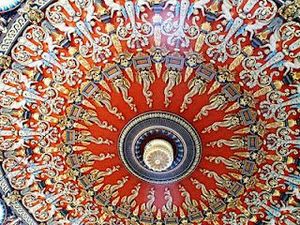
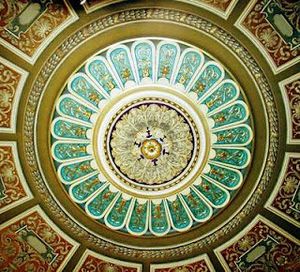






/https%3A%2F%2Fstorage.canalblog.com%2F08%2F12%2F353913%2F116988178_o.jpg)
/https%3A%2F%2Fstorage.canalblog.com%2F59%2F38%2F353913%2F115811794_o.jpg)
/https%3A%2F%2Fstorage.canalblog.com%2F00%2F54%2F353913%2F113969303_o.jpg)
/http%3A%2F%2Fp8.storage.canalblog.com%2F81%2F17%2F353913%2F59684501_p.jpg)